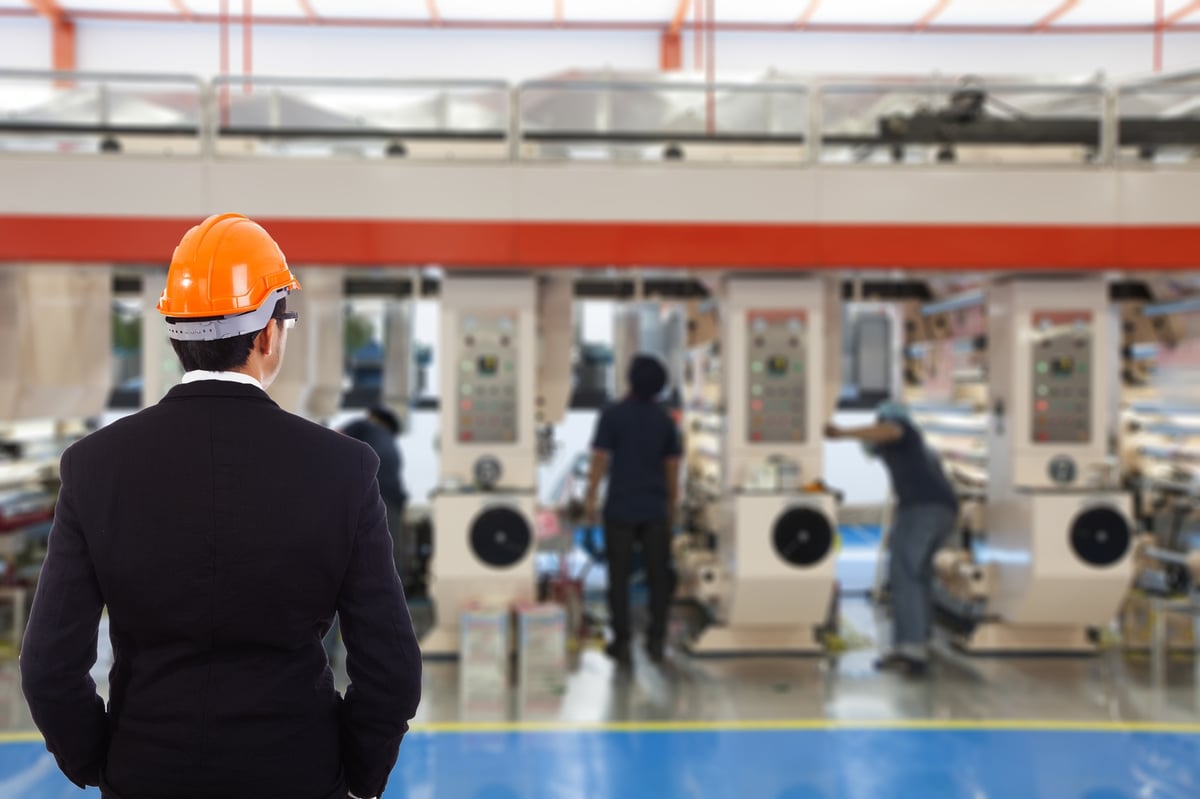September 28, 2021 | SMBs
How to Navigate the Top Manufacturing Challenges Facing Small and Medium-Sized Manufacturers
Managing and growing a small or medium-sized manufacturing organization involves multiple factors that don’t always come easily or work out smoothly. These common challenges range from issues with employee retention to updating your cybersecurity approach for protection in the 21st Century. How can you combat these challenges in your manufacturing organization?
Quick Links:
- Industry Outlook for Small to Medium Manufacturers
- Top 5 Challenges & Solutions for Small to Medium-Sized Manufacturers
Industry Outlook for Small and Medium-Sized Manufacturers
As was the case for many fields, the manufacturing industry was not spared disruption with the pandemic, but, in many ways, it forged ahead through unprecedented obstacles. Even though by the end of 2020, many industrial performance indicators still had not regained their pre-pandemic highs, the industry overall showed remarkable resilience, with 63% of executives in Deloitte’s postelection poll showing a somewhat or very positive outlook on business.
The future will vary for manufacturers depending on where they have felt the greatest impact from the pandemic. For some, it will focus on rebuilding lost revenue streams; for others, it could require recalibrating supply networks to serve different market demands. But for all manufacturers, there is value in a commitment to increasing agility in operations. Manufacturers are wise to set goals for data capture and analysis across the global manufacturing footprint, as this step alone is a key to identifying breakpoints and opportunities for improvement.
Top 5 Challenges & Solutions for Small and Medium-Sized Manufacturers
Challenge #1: Leveraging Technology
The manufacturing landscape continues to be driven by new technologies, from cloud computing and artificial intelligence to Industry 4.0 operations technologies such as Additive, Robotics and Machine Vision. New collaboration tools can help manufacturers to manage all these innovations.
Technology has the ability to enable more efficient operations, allow better communications internally and externally, and connect manufacturers with their now-smart customers. For small and medium-sized manufacturers, technology is vital to growth as it provides the ability to communicate better, understand, and deliver value to customers and to collaborate more efficiently with their own people.
Solution #1: Grow with Technology – Not Against It
To grow and move forward, small manufacturers understand the importance of having a sharp focus on customer needs. Technologies that can help you serve customers better while also serving employees will be critical in competing with larger, national, and international manufacturers.
As a manufacturer, having a clear technology roadmap is a powerful way to move your organization forward in this new digital world. New innovations and technologies are being developed quickly and smaller companies find it hard to keep up with these changes. The first place to begin is sitting down with your current OT and IT providers and vendors and creating a 3- to 5-year technology roadmap for your entire organization.
The digital transformation of manufacturing is not going to slow down. As a smaller manufacturer, you need to have a clear picture of where you are going and exactly what technologies you should embrace to get you there.

Challenge #2: Ample Cybersecurity Protections
As technology advances, so does the need for additional cybersecurity protections. Hackers can potentially make their way into IT and OT systems and cause major issues for manufacturers. So even if it might seem like a significant investment, putting protections in place is a must for businesses of any size.
Solution #2: Fortify your Cybersecurity Efforts
It’s critical to understand that it isn’t just your company that’s vulnerable: your customers, employees, and suppliers can also be digitally attacked and breached. 77% of industrial companies rank cybersecurity as a major priority.
The only way to prevent an attack from affecting all of them is to make sure you know your strengths and weaknesses when it comes to the cybersecurity plan for your manufacturing organization. Cybersecurity continues to be the number one “outside threat” for manufacturers of all sizes as a cyberattack occurs every 11 seconds.
Challenge #3: Increasing Automation
Large manufacturing businesses are becoming increasingly reliant on automation to run their day-to-day operations, which allows them to run more efficiently and at a lower cost.
However, for smaller manufacturing businesses, investing in that same type of equipment isn’t always possible. This puts them at a disadvantage in terms of both price and quality unless they’re able to find affordable financing options or simply focus on positioning their business differently in the marketplace.
Solution #3: Automation is the Future
Embracing automation can benefit companies, no matter the economic climate. Innovative technologies can provide new growth opportunities for small to medium-sized manufacturers as tasks can be completed with unprecedented speed and precision, while digital tools can increase real-time visibility into the production cycle so performance can be easily monitored.
Manufacturing automation is here to stay, and it’s here to help. Embracing these technologies does not entail cutting out jobs, which is what more than 70% of Americans fear. Qualified employees will still be needed to maintain and operate machines. Robots are not necessarily job takers but are there to protect employees from tasks that could do harm.
Challenge #4: Productivity & Efficiency
Low productivity can be an insidious problem that is hard to address or even notice immediately. For line workers, performing repetitive tasks day-to-day, year after year, can sometimes have a lulling effect. After all, it is human nature to get used to a certain way of doing things.
If there was a problem with production, would it be noticed just from walking around on the manufacturing floor? It’s not enough to just measure the productivity of your machines and equipment; you must also consider and evaluate the levels of employee productivity.
Solution #4: Investing in Your Employees Means Investing in Your Manufacturing Organization’s Growth
One of your best predictors of success for manufacturing growth is the talent of your workforce. In addition to weighing the investment in your manufacturing equipment, you must also consider the investment of your people. Hiring a long-term workforce can be an excellent return on investment, especially when data suggests that by the year 2030, low employee retention will, on average, cost the US $430 billion annually.
To begin, you must find enough qualified staff for the initial round of manufacturing growth. Once this process is streamlined, it is important to encourage your staff to remain for a longer period of time. To do so, they must be able to see professional growth at your company and transform their job into a career.
Sustaining a high level of talent will help your manufacturing facility become more effective and efficient. Think smart and invest in your talent to ensure future manufacturing growth.

Challenge #5: Budgeting & Labor Costs
Labor costs are often one of the largest line items on your company balance sheet. Therefore, a common challenge for manufacturing organizations is to adequately balance resourcing and cost controls. Hiring the most qualified individuals for open positions is often a difficult, costly, and time-intensive process that doesn’t necessarily guarantee the new employee will either want to stay or make it on the job.
Solution #5: Engaged Employees Are More Productive
If your team is not engaged, then it is likely that production is off-target. After all, companies with a highly engaged workforce have 21% higher profitability and have 17% higher productivity than companies with a disengaged workforce.
One way to ensure your employees are engaged is to share and align on a set of core values for your company. This process allows everyone in the organization to connect with the reasons why you do what you do and the standards by which you strive to do them. A set of company core values can support high productivity:
- Ensures that, when employees abide by company values, employees are at least within the same chapter or book, even when they aren’t on the same page.
- Makes meetings more productive and limits finger-pointing when companies have a common value of self-responsibility and accountability.
- Contributes to an overall sense of culture and solidarity, which improves teamwork and achieving goals.
CMTC is a private nonprofit organization that provides technical assistance, workforce development, and consulting services to small- and medium-sized manufacturers throughout the state of California. CMTC's mission is to serve as a trusted advisor, providing solutions that increase the productivity and competitiveness of California's manufacturers.
About the Author
Gregg Profozich
Gregg Profozich is a manufacturing, operations and technology executive who believes that manufacturing is the key creator of wealth in the economy and that a strong manufacturing sector is critical to our nation’s prosperity and security now, and for future generations. Across his 20-year plus career in manufacturing, operations and technology consulting, Mr. Profozich helped manufacturing companies from the Fortune 500 to the small, independents significantly improve their productivity and competitiveness.
